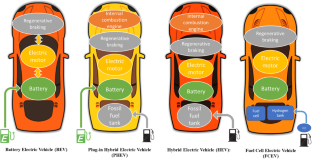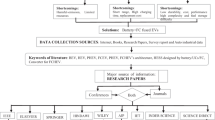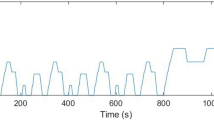Abstract
With the advancement of technology in recent decades and the implementation of international norms to minimize greenhouse gas emissions, automakers have focused on new technologies connected to electric/hybrid vehicles and electric fuel cell vehicles. Alternative fuel sources like hydrogen and electricity have been introduced as a sustainable, lower-emission alternative to burning fossil fuel. BEVs or battery electric vehicles are typical electric cars with a battery and electric motor that have to be charged. FCEVs, or fuel cell electric vehicles, have a fuel cell that converts pure hydrogen into electricity via reverse electrolysis to charge a battery connected to an electric motor. The lifecycle costs of the BEV and FCHEV are comparable; however, depending on driving patterns, one may be more advantageous than the other. This study compares the most recent proposed fuel-cell electric car topologies. This paper aims to find out which fuel alternative is more sustainable, looking forward to the future. An analysis was conducted by comparing different fuel cells’ and batteries’ efficiencies, performance, advantages, and disadvantages.


Similar content being viewed by others
Data availability
All relevant data and material are presented in the main paper.
Abbreviations
- BEV :
-
Battery electric vehicles
- FCEV :
-
Fuel cell, electric vehicle
- HCV :
-
Hydrogen combustion engine
- ICE :
-
Internal combustion engine
- PHEV :
-
Plug-in hybrid electric vehicle
- HEV :
-
Hybrid electric vehicle
- SMR :
-
Steam methane reforming
- PEMFC :
-
Proton electron membrane fuel cells
- PEM :
-
Proton electron membrane
- AEMFC :
-
Anion exchange membranes fuel cells
- MCFC :
-
Molten carbonate fuel cells
- SOFC :
-
Solid oxide fuel cell
References
Andrew-Munot M, Ibrahim RN, Junaidi E (2015) An Overview of Used-Products Remanufacturing. Mech Eng Res 5(1):12
Bhagavathy S, Thakur J (2022) Green Hydrogen: Challenges for Commercialization. Smartgrid.Ieee.Org. February-2021
Bhosale, Amit C, Suseendiran SR, Ramya R, Suman Roy Choudhury, Rengaswamy R (2022a) Phosphoric Acid Fuel Cells. Comprehensive Renewable Energy 437–58. https://doi.org/10.1016/B978-0-12-819727-1.00006-6
Bhosale, Amit C, Suseendiran SR, Ramya R, Suman Roy Choudhury, Rengaswamy R (2022b) Phosphoric Acid Fuel Cells. Comprehensive Renewable Energy 437–58. https://doi.org/10.1016/B978-0-12-819727-1.00006-6
Bindner H, Cronin T, Lundsager P (2005) “Lifetime Modelling of Lead Acid Batteries”
Chandra D, Chien WM, Talekar A (2011) “Metal Hydrides for NiMH Battery Applications - Google Scholar.” Retrieved August 31, 2022 https://scholar.google.com/scholar?hl=en&as_sdt=0%2C5&q=Metal+Hydrides+for+NiMH+Battery+Applications&btnG=
Chu, Changbao, Qing Xu, Xingjian Jia, Qiushi Hu, and Linghong Xu (2021) An Overview on Lithium-Ion Batteries Recycling Processes. Journal of Physics: Conference Series 1885(3):032031. https://doi.org/10.1088/1742-6596/1885/3/032031
Cloud M (2020) “What Is the Energy Density of a Lithium-Ion Battery?” Retrieved August 30, 2022 https://www.fluxpower.com/blog/what-is-the-energy-density-of-a-lithium-ion-battery
Crini G, Lichtfouse E (2019) Advantages and Disadvantages of Techniques Used for Wastewater Treatment. Environ Chem Lett 17(1):145–155. https://doi.org/10.1007/s10311-018-0785-9
Davies G (2012) Materials for Automobile Bodies. Materials for Automobile Bodies. https://doi.org/10.1016/C2010-0-66319-X
Dong H, Fu J, Zhao Z, Liu Q, Li Y, Liu J (2020) A Comparative Study on the Energy Flow of a Conventional Gasoline-Powered Vehicle and a New Dual Clutch Parallel-Series Plug-in Hybrid Electric Vehicle under NEDC. Energy Convers Manag 218:113019
Duffner F, Wentker M, Greenwood M, Leker J (2020) Battery Cost Modeling: A Review and Directions for Future Research. Renew Sustain Energy Rev 127:109872
Energy, Ergon (2015) “Benefits Of Electric Cars”
Engineering, O. Popovici-Journal of Electrical and Electronics, and undefined 2014. n.d. “The Study of the Efficiency of a Direct Methanol Fuel Cell.” Search.Proquest.Com.
Fayez Youssif, Yasir, Mahdi Hatf Kadhum, and Ahmed Hammodi Ali (2020) “IOP Conference Series: Earth and Environmental Science Study of Fuel Efficiency of Hybrid Vehicles You May Also like Experimental Study for Laminar Forced Convection Heat Transfer Enhancement from Horizontal Tube Heated with Constant Heat Flux, by Using Different Types of Porous Media.” https://doi.org/10.1088/1755-1315/459/2/022086
Ferriday TB, Middleton PH (2021) Alkaline Fuel Cell Technology - A Review. Int J Hydrogen Energy 46(35):18489–18510. https://doi.org/10.1016/J.IJHYDENE.2021.02.203
Fetcenko M, Koch J, Zelinsky M (2015) Nickel–Metal Hydride and Nickel–Zinc Batteries for Hybrid Electric Vehicles and Battery Electric Vehicles. Advances in Battery Technologies for Electric Vehicles 103–26. https://doi.org/10.1016/B978-1-78242-377-5.00006-6
Foley B, Degirmenci K, Yigitcanlar T (2020) Factors Affecting Electric Vehicle Uptake: Insights from a Descriptive Analysis in Australia. Urban Sci 4(4):57
Forte F, Pietrantonio M, Pucciarmati S, Puzone M, Fontana D (2021) Lithium Iron Phosphate Batteries Recycling: An Assessment of Current Status. Crit Rev Environ Sci Technol 51(19):2232–2259. https://doi.org/10.1080/10643389.2020.1776053
Gandoman FH, Jaguemont J, Goutam S, Gopalakrishnan R, Firouz Y, Kalogiannis T, Omar Noshin, van Mierlo Joeri (2019) Concept of Reliability and Safety Assessment of Lithium-Ion Batteries in Electric Vehicles: Basics, Progress, and Challenges. Appl Energy 251:113343. https://doi.org/10.1016/J.APENERGY.2019.113343
Gondal IA, Masood SA, Khan R (2018) Green Hydrogen Production Potential for Developing a Hydrogen Economy in Pakistan. Int J Hydrogen Energy 43(12):6011–6039. https://doi.org/10.1016/j.ijhydene.2018.01.113
Gong Y (2018) Chromium Poisoning in Cathodes of Solid Oxide Fuel Cells: The Role of Current Density, Humidity, and Cathode Composition, and Strategies for Mitigation
Gupta S, Pathak B (2020) Mycoremediation of polycyclic aromatic hydrocarbons. In Abatement of environmental pollutants. Elsevier. pp. 127-149
Habib ARR, Butler K (2022) Environmental and economic comparison of hydrogen fuel cell and battery electric vehicles. Future Technol1(2):25-33.https://doi.org/10.55670/fpll.futech.1.2.3
Helmers E, Marx P (2012) Electric Cars: Technical Characteristics and Environmental Impacts. Environ Sci Eur 24(4):1–15. https://doi.org/10.1186/2190-4715-24-14/FIGURES/2
Hossain MS, Kumar L, El Haj Assad M, Alayi R (2022) Advancements and Future Prospects of Electric Vehicle Technologies: A Comprehensive Review. edited by X. Bai. Complexity 2022:1–21.https://doi.org/10.1155/2022/3304796
Hu, Yi, Yongbing Xu, Li Liu, M. Koniak, and A. Czerepicki (2017) Selection of the Battery Pack Parameters for an Electric Vehicle Based on Performance Requirements. https://doi.org/10.1088/1757-899X/211/1/012005
Kordesch K, Hacker V, Gsellmann J, Cifrain M, Faleschini G, Enzinger P, Fankhauser R, Ortner M, Muhr M, Aronson RR (2000) Alkaline Fuel Cells Applications. J Power Sources 86(1–2):162–165
Korn T (2020) (2020) The Hydrogen Engine Is on Its Way. MTZ Worldwide 81(7):74–74. https://doi.org/10.1007/S38313-020-0255-1
Kulkarni A, Giddey S (2012) Materials Issues and Recent Developments in Molten Carbonate Fuel Cells. J Solid State Electrochem 16:3123–3146. https://doi.org/10.1007/s10008-012-1771-y
Lee JW, Kim JI, Roh KC (2012) Lithium Manganese Oxide with Excellent Electrochemical Performance Prepared from Chemical Manganese Dioxide for Lithium Ion Batteries. Solid State Sci 14(9):1251–1255
Lelieveld J, Klingmüller K, Pozzer A, Burnett RT, Haines A, Ramanathan V (2019) Effects of Fossil Fuel and Total Anthropogenic Emission Removal on Public Health and Climate. Proc Natl Acad Sci USA 116(15):7192–7197. https://doi.org/10.1073/PNAS.1819989116/SUPPL_FILE/PNAS.1819989116.SD02.XLSX
Lencwe, MJ, … SPD Chowdhury-2017 IEEE PES, and undefined (2017) “Performance Studies of Lead Acid Batteries for Transport Vehicles.” Ieeexplore.Ieee.Org
Li, Yanwei, Yugui Li, Peisheng Han, Weiquan Li, Yang Wang, and Weinan Liu (2020) IOP Conference Series: Earth and Environmental Science A Review of Solid Oxide Fuel Cell Application Predictive Simulation of Single Cylinder n-Butanol HCCI Engine Muhammad Faizullizam Roslan, Ibham Veza and Mohd Farid Muhamad Said-Effect of Hot Rolling on Microstructure and Properties of High-Chromium Cast Iron Hardfacing Cladding Plate A Review of Solid Oxide Fuel Cell Application. https://doi.org/10.1088/1755-1315/619/1/012012
Liu S, Boya Wang Xu, Zhang SZ, Zhang Z, Haijun Yu (2021) Reviving the Lithium-Manganese-Based Layered Oxide Cathodes for Lithium-Ion Batteries. Matter 4(5):1511–1527. https://doi.org/10.1016/J.MATT.2021.02.023
Lu C, Zhang R, Yang G, Huang H, Cheng J, Shisen Xu (2021) Study and Performance Test of 10 KW Molten Carbonate Fuel Cell Power Generation System. Int J Coal Sci Technol 8(3):368–376. https://doi.org/10.1007/S40789-021-00442-4/FIGURES/9
Manoharan Y, Hosseini SE, Butler B, Alzhahrani H, Senior BTF, Ashuri T, Krohn J (2019) Hydrogen Fuel Cell Vehicles; Current Status and Future Prospect. Appl Sci 9(11):2296. https://doi.org/10.3390/app9112296
Manzetti S, Mariasiu F (2015) Electric Vehicle Battery Technologies: From Present State to Future Systems. Renew Sustain Energy Rev 51:1004–1012. https://doi.org/10.1016/J.RSER.2015.07.010
Naumanen M, Uusitalo T, Huttunen-Saarivirta E, van der Have R (2019) Development Strategies for Heavy Duty Electric Battery Vehicles: Comparison between China, EU, Japan and USA. Resources, Conservation and Recycling 151:104413. https://doi.org/10.1016/J.RESCONREC.2019.104413
Nemeth T, Schröer Philipp, Kuipers Matthias, Sauer Dirk Uwe (2020a) Lithium Titanate Oxide Battery Cells for High-Power Automotive Applications – Electro-Thermal Properties, Aging Behavior and Cost Considerations. Journal of Energy Storage 31:101656. https://doi.org/10.1016/J.EST.2020.101656
Nemeth T, Schröer Philipp, Kuipers Matthias, Sauer Dirk Uwe (2020b) Lithium Titanate Oxide Battery Cells for High-Power Automotive Applications – Electro-Thermal Properties, Aging Behavior and Cost Considerations. Journal of Energy Storage 31:101656. https://doi.org/10.1016/J.EST.2020.101656
Nesaraj AS (2010) Recent Developments in Solid Oxide Fuel Cell Technology-a Review. NESARAJ: RECENT DEVELOPMENTS IN SOLID OXIDE FUEL CELL TECHNOLOGY-A REVIEW. J Sci Ind Res 69:169–76
Nicolau BG, Petronico Aaron, Letchworth-Weaver Kendra, Ghadar Yasaman, Haasch Richard T, Soares Julio A N T, Rooney Ryan T, Chan Maria K Y, Gewirth Andrew A, Nuzzo Ralph G, Nicolau BG, Petronico A, Rooney RT, Gewirth AA, Nuzzo RG, Haasch RT, Soares JANT, Letchworth-Weaver K, Chan MKY, Ghadar Y (2018) Controlling Interfacial Properties of Lithium-Ion Battery Cathodes with Alkylphosphonate Self-Assembled Monolayers. Wiley Online Library 5(10):1701292. https://doi.org/10.1002/admi.201701292
Nitta N, Feixiang Wu, Lee JT, Yushin G (2015) Li-Ion Battery Materials: Present and Future. Mater Today 18(5):252–264. https://doi.org/10.1016/J.MATTOD.2014.10.040
Noga M, Juda Z (2019) The Application of Nimh Batteries in a Light-Duty Electric Vehicle Zastosowanie Akumulatorów Nimh w Lekkim Użytkowym Pojeździe Elektrycznym. Repozytorium.Biblos.Pk.Edu.Pl. https://doi.org/10.4467/2353737XCT.19.014.10054
Norwood Zack, Kammen Daniel (2012) Life Cycle Analysis of Distributed Concentrating Solar Combined Heat and Power: Economics, Global Warming Potential and Water. Environ Res Lett 7(4):044016. https://doi.org/10.1088/1748-9326/7/4/044016
Omar N, van den Bossche P, Mulder G, Daowd M, Timmermans JM, van Mierlo J, Pauwels S (2011) “Assessment of Performance of Lithium Iron Phosphate Oxide, Nickel Manganese Cobalt Oxide and Nickel Cobalt Aluminum Oxide Based Cells for Using in Plug-in Battery Electric Vehicle Applications. 2011 IEEE Vehicle Power and Propulsion Conference, VPPC 2011. https://doi.org/10.1109/VPPC.2011.6043017
Peighambardoust SJ, Rowshanzamir S, Amjadi M (2010) Review of the Proton Exchange Membranes for Fuel Cell Applications. Int J Hydrogen Energy 35(17):9349–9384. https://doi.org/10.1016/J.IJHYDENE.2010.05.017
Perera Frederica (2018) Pollution from Fossil-Fuel Combustion Is the Leading Environmental Threat to Global Pediatric Health and Equity: Solutions Exist. International Journal of Environmental Research and Public Health 15(1):16. https://doi.org/10.3390/IJERPH15010016
Pollet BG, Franco AA, Su H, Liang H, Pasupathi S (2016) Proton Exchange Membrane Fuel Cells. Compendium of Hydrogen Energy 3–56. https://doi.org/10.1016/B978-1-78242-363-8.00001-3
Rand DAJ, Moseley PT (2015) Energy Storage with Lead–Acid Batteries. Electrochemical Energy Storage for Renewable Sources and Grid Balancing 201–22. https://doi.org/10.1016/B978-0-444-62616-5.00013-9
Remick R, Wheeler D (2010) Molten Carbonate and Phosphoric Acid Stationary Fuel Cells: Overview and Gap Analysis
Sanguesa JA, Torres-Sanz Vicente, Garrido Piedad, Martinez Francisco J, Marquez-Barja Johann M (2021) A Review on Electric Vehicles: Technologies and Challenges. Smart Cities 4(1):372–404. https://doi.org/10.3390/SMARTCITIES4010022
Shikhar U, Hemmes K, Woudstra T (2021) Exploring the Possibility of Using Molten Carbonate Fuel Cell for the Flexible Coproduction of Hydrogen and Power. Frontiers in Energy Research 9:394. https://doi.org/10.3389/FENRG.2021.656490/BIBTEX
Standmacher K, Kienle A, Pesch H, Berndt JF, Huppmann G, Bicentennial J Cd (2007) Molten Carbonate Fuel Cells
Sudhakar, Y. N., M. Selvakumar, and D. Krishna Bhat. 2018. “Biopolymer Electrolytes for Fuel Cell Applications.” Biopolymer Electrolytes 151–66. doi: https://doi.org/10.1016/B978-0-12-813447-4.00005-4.
Sun YK (2020) Promising All-Solid-State Batteries for Future Electric Vehicles. ACS Energy Lett 5(10):3221–3223. https://doi.org/10.1021/ACSENERGYLETT.0C01977
Sundmacher, Kai, Achim Kienle, Hans Josef Pesch, Joachim F. Berndt, and Gerhard Huppmann (2007) “Molten Carbonate Fuel Cells: Modeling, Analysis, Simulation, and Control.” Molten Carbonate Fuel Cells: Modeling, Analysis, Simulation, and Control 1–243. https://doi.org/10.1002/9783527611324
Suominen A (2010) Analyzing the Direct Methanol Fuel Cell Technology in Portable Applications by a Historical and Bibliometric Analysis. J Bus Chem
Taner T (2018) Introductory Chapter: An Overview of PEM Fuel Cell Technology. Proton Exchange Membrane Fuel Cell. https://doi.org/10.5772/INTECHOPEN.71544
Tarroja B, Zhang L, Wifvat V, Shaffer B, Samuelsen S (2016) Assessing the Stationary Energy Storage Equivalency of Vehicle-to-Grid Charging Battery Electric Vehicles. Energy 106:673–690
Tseng Y-M, Huang H-S, Chen L-S, Tsai J-T (2018) Characteristic Research on Lithium Iron Phosphate Battery of Power Type. https://doi.org/10.1051/matecconf/201818500004
Verhelst S, Wallner T (2016) Hydrogen-Fueled Internal Combustion Engines
Wei T, Zhou X, Qiang Hu, Gao Q, Han Da, Lv X, Wang S (2014) A High Power Density Solid Oxide Fuel Cell Based on Nano-Structured La0.8Sr0.2Cr0.5Fe0.5O3-δ Anode. Electrochim Acta 148:33–38. https://doi.org/10.1016/J.ELECTACTA.2014.10.020
Wind J (2016) Hydrogen-Fueled Road Automobiles – Passenger Cars and Buses. Compendium of Hydrogen Energy 3–21. https://doi.org/10.1016/B978-1-78242-364-5.00001-4
Xing Y, Li Haibin, Avgouropoulos George (2021) Research Progress of Proton Exchange Membrane Failure and Mitigation Strategies. Materials 14(10):2591. https://doi.org/10.3390/MA14102591
Xu C, Dai Qiang, Gaines Linda, Mingming Hu, Tukker Arnold, Steubing Bernhard (2020) Future Material Demand for Automotive Lithium-Based Batteries. Commun Mater 1(1):1–10. https://doi.org/10.1038/s43246-020-00095-x
Xu F, Yue Su, Lin B (2020) Progress of Alkaline Anion Exchange Membranes for Fuel Cells: The Effects of Micro-Phase Separation. Frontiers in Materials 7:4. https://doi.org/10.3389/FMATS.2020.00004/XML/NLM
Zhang R, Xia Bizhong, Li Baohua, Lai Yongzhi, Zheng Weiwei, Wang Huawen, Wang Wei, Wang Mingwang (2018a) Study on the Characteristics of a High Capacity Nickel Manganese Cobalt Oxide (NMC) Lithium-Ion Battery—An Experimental Investigation. Energies 11(9):2275. https://doi.org/10.3390/EN11092275
Zhang R, Xia Bizhong, Li Baohua, Lai Yongzhi, Zheng Weiwei, Wang Huawen, Wang Wei, Wang Mingwang (2018b) Study on the Characteristics of a High Capacity Nickel Manganese Cobalt Oxide (NMC) Lithium-Ion Battery—An Experimental Investigation. Energies 11(9):2275. https://doi.org/10.3390/EN11092275
Zhu WH, Zhu Y, Davis Z, Tatarchuk BJ (2013) Energy Efficiency and Capacity Retention of Ni–MH Batteries for Storage Applications. Appl Energy 106:307–313. https://doi.org/10.1016/J.APENERGY.2012.12.025
Zhu Z, Wang M, Meng Y, Lin Z, Cui Yi, Chen W (2020) A High-Rate Lithium Manganese Oxide-Hydrogen Battery. Nano Lett 20(5):3278–3283. https://doi.org/10.1021/ACS.NANOLETT.0C00044/SUPPL_FILE/NL0C00044_SI_001.PDF
Acknowledgements
The authors are grateful to School of Energy Technology, Pandit Deendayal Energy University, for the permission to publish this review.
Author information
Authors and Affiliations
Contributions
All the authors make substantial contribution in writing the manuscript. AP, MS, and MP participated in drafting the manuscript. AP and MS wrote the main manuscript, and all the authors discussed the review and implication on the manuscript at all stages.
Corresponding author
Ethics declarations
Ethics approval and consent to participate
Not applicable.
Consent for publication
Not applicable.
Competing interests
The authors declare no competing interests.
Additional information
Responsible Editor: Philippe Garrigues
Publisher's Note
Springer Nature remains neutral with regard to jurisdictional claims in published maps and institutional affiliations.
Rights and permissions
Springer Nature or its licensor (e.g. a society or other partner) holds exclusive rights to this article under a publishing agreement with the author(s) or other rightsholder(s); author self-archiving of the accepted manuscript version of this article is solely governed by the terms of such publishing agreement and applicable law.
About this article
Cite this article
Parikh, A., Shah, M. & Prajapati, M. Fuelling the sustainable future: a comparative analysis between battery electrical vehicles (BEV) and fuel cell electrical vehicles (FCEV). Environ Sci Pollut Res 30, 57236–57252 (2023). https://doi.org/10.1007/s11356-023-26241-9
Received:
Accepted:
Published:
Issue Date:
DOI: https://doi.org/10.1007/s11356-023-26241-9




